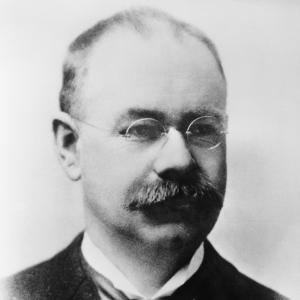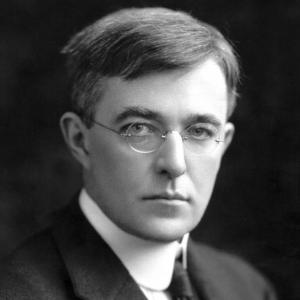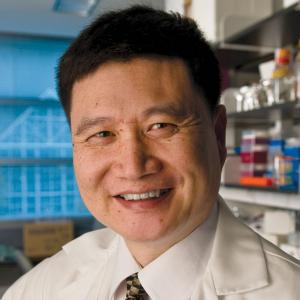A Lever Long Enough
From its beginning as King’s College in 1754, Columbia valued the academic disciplines of science, engineering, and mathematics. Indeed, some of Columbia’s early alumni were pioneering entrepreneurs and engineers. John Stevens (Class of 1768) developed steam engines that powered both the first steamships to navigate the open ocean and the first steam locomotive. As governor of New York, DeWitt Clinton (Class of 1786) was the driving force behind the Erie Canal, which connected New York City to the burgeoning Midwest. Horatio Allen (Class of 1823) was an early president of the American Society of Civil Engineers.

Timeline
View a timeline of Columbia Engineering

The School of Mines Class of 1877 included international students from Liberia and Brazil.
But it was only in 1863 that Thomas Egleston—then a mineralogist working at the Smithsonian Institution—suggested that Columbia create a separate school of metallurgy and mining. In less than a year, on November 15, 1864, the School of Mines of Columbia College opened its doors, with a student body of 20 and a faculty of three. The new school reflected in many ways the demands of its age, recognizing the need for raw materials to wage the Civil War and to supply the rapid industrialization of the United States.
Since then, Columbia Engineering has grown and expanded on every front. Today the School is home to more than 170 faculty members, 1,500 undergraduate students, 2,000 master’s degree students, and 700 doctoral students. The School quickly moved from a simple focus on mining to include civil engineering, chemical engineering, and electrical engineering. We now have a robust set of nine departments. We’ve moved from being a bastion of the city’s male Knickerbocker elite to a global institution, attracting students from around the world and an entering undergraduate class that is 44 percent women. The School’s footprint has grown as well, as we’ve moved from Midtown to Morningside Heights and from one building to multiple campus locations. Our school’s curriculum still reflects Columbia’s unfailing commitment to liberal arts instruction, while pushing the frontiers of technology and applied science.
The Fu Foundation School of Engineering and Applied Science can boast of a rich history of pioneering education, research, and innovation. Professor Robert McCaughey’s A Lever Long Enough, written on the occasion of the School’s sesquicentennial, offers an insightful look at the birth and evolution of an engineering school that has grown within the context of a renowned research university, evolved with the disciplines that it pursues, and interacted dynamically with its city, its country, and the world. Like any great institution, Columbia Engineering has been shaped by strong personalities, weathered terrible storms, and enjoyed remarkable individual and institutional success. Columbia Engineering’s steadfast commitment to excellence has manifested itself not simply in academic pursuits but also in pushing beyond conventional disciplinary frontiers.

DeWitt Clinton

Horatio Allen

Thomas Egleston
Throughout its history, Columbia Engineering has always focused both on academic pursuits and on engagement with the world. The first dean of the Columbia School of Mines, Charles F. Chandler, set a high benchmark. A chemist by training, Chandler also emerged as a major public health advocate. Working with New York City’s Metropolitan Board of Health from 1866 to 1883, he developed standards for clean and safe drinking water, milk for babies, and medicines. A vocal supporter of improved tenement housing, including mandatory indoor plumbing, he has been credited with preventing a cholera epidemic in 1883.
Chandler’s 32-year leadership of our school marked a period of significant engineering and scientific advancements, not only in chemistry and chemical engineering but also in electrical engineering, civil engineering, and nascent computer science.
When Herman Hollerith (Class of 1879), who had been a statistician for the 1880 U.S. census, returned to Columbia for graduate studies, he set about finding a new way to process census data. His doctoral thesis described a punch card system in which the cards could be counted and sorted mechanically. Awarded a PhD in 1890, Hollerith went on to found the Tabulating Machine Company in 1896, which merged with three other companies to form what became International Business Machines (IBM) in 1924. Today Hollerith is recognized as the father of modern automatic computation.

The Chemical Engineering Department was created in 1915. Daniel Dana Jackson served as founding chair.

Charles Chandler

Herman Hollerith

Michael Pupin
Few engineers, however, can match the achievements of Michael Pupin (Class of 1883). By 1882, when Thomas Edison wrote to Columbia President Frederick Barnard about the need to educate “electrical scientists” to work for his new company, Pupin was among the Columbia students already experimenting with electricity. After graduate study in England and Germany, in 1889 Pupin joined the faculty of the newly formed Department of Electrical Engineering. Over the next four decades, Pupin won more than 30 patents in fields ranging from electricity to medicine, from telephony to sonar. Using a fluorescent screen given to him by Thomas Edison, Pupin developed an X-ray method that produced usable images while reducing radiation exposure from one hour to just a few minutes. In 1899, he patented the “Pupin Coil,” which made long-distance telephony feasible; he later sold the patent to American Telephone and Telegraph.
One of Pupin’s pupils, Edwin H. Armstrong (Class of 1913), invented the regenerative circuit while he was still an undergraduate. Upon graduation, he joined the School’s faculty. Commissioned as an officer in the Army Signal Corps during World War I, Armstrong developed the superheterodyne circuit. After the war, he returned to Columbia, where he developed the superregenerative circuit and, in 1933, completed his most famous invention: FM radio. Although best known as the “father of FM radio,” Armstrong’s inventions actually underlie all modern radio, radar, and television.
In civil engineering, William Barclay Parsons (Class of 1882) was building some of the major transportation projects of the day—railroads, rapid transit, and canals. Parsons and his younger brother Harry, a mechanical engineer, opened up their own consulting engineering office in New York in 1885. The Parsons firm had a global impact on the built environment, with projects ranging from hydroelectric plants across the United States to docks in Cuba, from China’s Hankow-to-Canton railroad to the Cape Cod Canal.
In 1894, Parsons became chief engineer of the New York Rapid Transit Commission, designing the Interborough Rapid Transit subway, which opened in 1904. That subway network secured Parsons’s place in history and revolutionized transportation in the metropolis. Parsons maintained a lifelong relationship with Columbia, serving on the Board of Trustees from 1897 to 1932, the last 15 years as its chair. His firm, now called Parsons Brinckerhoff, remains a leader in the design, construction, and operation of critical infrastructure around the world.

Edwin Armstrong

Irving Langmuir

Colin Fink
A pioneering chemist, Irving Langmuir (Class of 1903) worked at the intersection of chemistry, physics, and engineering, investigating the properties of adsorbed films and the nature of electric discharges in high vacuum and in certain gases. He was awarded the Nobel Prize in Chemistry in 1932 “for his outstanding discoveries and investigations within the field of surface chemistry.”
After graduate study at Leipzig, Colin Fink (Class of 1903) worked for General Electric and later as chief chemist for the Chile Exploration Company. In 1921, he joined the faculty, heading up a new branch of chemical engineering, electrochemistry. Fink developed a chromium-plating process that is still used today as the standard for plating metal or plastic. His pioneering electrochemistry research led to ductile tungsten for incandescent lamp filaments, an insoluble anode for electrowinning copper, an electrolytic process to remove corrosion from antique bronzes, and several electroplating processes.
By the 1930s, Columbia Engineering alumni and professors were pushing the boundaries of their disciplines. Raymond D. Mindlin (Class of 1931), who joined the Civil Engineering faculty in 1940, was the most outstanding elastician of his generation, making contributions to the fields of applied physics, applied mechanics, and engineering science. In 1946, President Harry Truman awarded Mindlin the Medal for Merit for his work developing the radio proximity fuse, a detonator used extensively in World War II. In 1979, President Jimmy Carter awarded him the National Medal of Science. Maurice A. Biot, who joined the Civil Engineering Department in 1937, was another pioneering researcher, laying the foundations of the theory of poroelasticity (now known as Biot Theory), which describes the mechanical behavior of fluid-saturated porous media.
As the nation began to recover from World War II, the School began to reassert itself in a variety of areas. In electrical engineering, faculty and alumni set a new standard for industrial impact. The “father of robotics,” Joseph Engelberger BS’46, MS’49 developed the Unimate robot—the first industrial robot in the United States. His industrial robots, which first appeared on automobile assembly lines in 1961, revolutionized countless manufacturing processes. Today his newest robots assist in human care, especially with the elderly.
John R. Ragazzini PhD’41, who had worked on the Manhattan Project, collaborated with Loebe Julie to develop and build the world’s first modern differential operational amplifier in 1947. In 1952, Ragazzini and faculty colleague Lotfi A. Zadeh PhD’49 established the z-transform method that is still the standard in digital signal processing and other discrete-time systems. Rudolf E. Kálmán PhD’57 developed the Kalman filter, a mathematical algorithm widely used in many prediction models. In 2009, President Barack Obama awarded him the National Medal of Science. Robert Moog MS’56 revolutionized music with his invention of the Moog synthesizer, the first voltage-controlled subtractive synthesizer played via keyboard.

Elmer Gaden (right) BS'44, MS'47, PhD'49, "the father of biomedical engineering."
In chemical engineering, Professor Elmer Gaden BS’44, MS’47, PhD’49 demonstrated that an optimal amount of oxygen enabled penicillin mold to grow and multiply more rapidly. This research formed the basis for mass production of a wide range of antibiotics, beginning with penicillin, and earned Gaden the title of “father of biochemical engineering.”
In mechanical engineering, Professor Ferdinand Freudenstein PhD’54 developed the precursor of what is now known as the Freudenstein Equation, which uses a simple algebraic method to determine the position of an output lever in a linkage mechanism. Freudenstein later applied digital computation to the kinematic synthesis of mechanisms, earning him recognition as the “father of modern kinematics.”
Near the end of World War II, IBM established the Watson Scientific Computing Lab at Columbia, and the lab staff started teaching the first ever computer science courses fully integrated into a university curriculum. Joseph Traub MS’55, PhD’59 gained early access to computers through graduate work in the Watson Lab. Traub’s doctoral thesis examined computational quantum mechanics, and he continued his pioneering work in optimal iteration theory, developing significant new algorithms at Bell Labs, the University of Washington, and Carnegie Mellon University before returning to Columbia in 1979 as the founding chair of the Department of Computer Science.
Near the end of World War II, IBM established the Watson Scientific Computing Lab at Columbia, and the lab staff started teaching the first ever computer science courses fully integrated into a university curriculum.
The 1950s and 1960s witnessed interdisciplinary initiatives that applied engineering principles to medicine and the study of the human body. In 1968, Edward F. Leonard conducted path-breaking research in the engineering and design of artificial organs. Richard Skalak BS’43, PhD’54 integrated engineering mechanics and biomedical science to understand the mechanics of blood flow, bone growth, white blood cell response to infections, and biological implications of and responses to implants.
Sebastian Littauer MS’28, who joined the Department of Industrial Engineering in 1947, introduced the first courses in operations research at Columbia in 1952. By the 1990s, with the resurgence of Wall Street, the renamed Department of Industrial Engineering and Operations Research was expanding into financial engineering.
Van C. Mow joined Columbia in 1985 as the first joint faculty appointment between Columbia Engineering and the College of Physicians and Surgeons (P&S). A decade later, Mow and Leonard, joined by W. Michael Lai and Gerard Ateshian of the Department of Mechanical Engineering, became the founding faculty for a biomedical engineering program. Under Mow’s leadership, the new program won additional support, hired new faculty, and expanded its partnership with P&S. In 2000, University Trustees approved a Department of Biomedical Engineering, creating the School’s ninth department.
Meanwhile, the School’s Mining and Metallurgy Department (christened the Henry Krumb School of Mines, in a nod to the School’s original mission) pivoted to embrace environmental study, later becoming the Department of Earth and Environmental Engineering. It began to support new research initiatives, including the Earth Engineering Center and the Waste to Energy Research and Technology Council, and organized the First International Conference on Environmental Issues and Waste Management in Energy and Minerals Production.
As the twentieth century came to a close, a transformational donation propelled the School forward in its mission. A $26 million gift from businessman and philanthropist Z. Y. Fu in 1997 targeted four areas—computer science, biomedical engineering, applied mathematics, and electrical engineering—and gave the School a new name. The new resources enabled the School to expand, attracting and retaining new faculty talent and increasing interdisciplinary collaboration within the School and with other divisions of the University.
By the beginning of the twenty-first century, Columbia Engineering had developed a new paradigm of highly interdisciplinary engineering and applied science research. Columbia Engineering professors eagerly responded to major challenges that were inherently interdisciplinary and could only be met with an expansive approach.
In the early 1990s, Dimitris Anastassiou and his student Fermi Wang PhD’91 developed a key patent essential to the MPEG-2 video and systems coding standards used in TVs, DVD players and recorders, personal computers, computer gaming, and cameras. But then, Anastassiou shifted his research to systems biology, specifically cancer research. He has developed a new computational model to predict breast cancer survival and is searching for precise genetic signatures present in multiple types of cancer.
Jingyue Ju, who joined the Department of Chemical Engineering in 1999, has directed his research toward biomolecular applications for personalized medicine. His revolutionary research developed a novel DNA-sequencing platform that heralds a new era in the field. His innovations could reduce the cost of DNA sequencing, so that it can become a routine part of medical research and individualized health care.

Kathleen McKeown

Jingyue Ju

Gordana Vunjak-Novakovic
In 2005, Gordana Vunjak-Novakovic joined the Department of Biomedical Engineering. Expanding the department’s strength in tissue engineering, she has developed novel bioreactors to advance her research on engineering functional tissues. She has successfully grown bone grafts that can match a patient’s original jawbone for facial reconstruction surgery and has engineered functional cardiac tissue.
Founded in 1978, what is now the Department of Applied Physics and Applied Mathematics quickly expanded beyond its original core of plasma physics and nuclear science to include areas such as solid-state physics. Today Adam Sobel uses sophisticated climate modeling in his research of extreme weather events, such as hurricanes, and their relation to climate, seeking engineering solutions to ameliorate the social impact of extreme weather.
Computer Science expanded into new areas as well. In 2001, Kathleen McKeown, a leading scholar in the field of natural language processing, developed Newsblaster, a trail-blazing system that automatically identifies, sorts, and summarizes the day’s top news stories; now she is beginning research on using data from social media to track and respond to disasters. Shih-Fu Chang has developed information analysis and machine-learning techniques to process voluminous online video images into useful data and conduct unprecedented searches using large visual databases. Eitan Grinspun integrates concepts from graphics, applied mathematics, and engineering, applying the budding field of discrete differential geometry to create practical computations that enable film studios to produce detailed, lifelike animation.
In mechanical engineering, Vijay Modi uses engineering to transform both developing and highly developed regions of the world. His research optimizes electric grids, not only in New York City but also in self-contained micro-grids that supply local power in the developing world. He currently leads the UN Millennium Villages Project on the role of energy and energy services.
Columbia Engineering now stands at the nexus of many of the University’s interdisciplinary initiatives. Engineering professors are making key contributions to the Earth Institute’s initiatives in water, climate, energy, and sustainability. Engineering professors are helping shape the new Mortimer Zuckerman Mind Brain Behavior Institute, which is closing the gap between our fundamental understanding of the brain and what the social sciences, humanities, and professional disciplines tell us about behavior.
In 2012, the University announced the launch of the new Institute for Data Sciences and Engineering, which is poised to become a world-leading institution in research and education in the theory and practice of the emerging field of data science. Based at Columbia Engineering and led by Engineering professors, the Institute’s six centers encompass faculty from nine University schools, an acknowledgment not only of the Institute’s inherently interdisciplinary subject matter but also of engineering’s pivotal place in meeting all aspects of the challenge.
This year’s sesquicentennial celebration is an unprecedented opportunity to contemplate our school’s bright future even as we celebrate our storied past. I firmly believe that we are in a Renaissance for engineering—a period of great research, great innovation, great invention, and incredible translation of these innovations to solutions that will benefit people around the world. We are privileged to build on our school’s remarkable legacy in a time when engineering and the applied sciences have never been more important to the progress of society.
As we embark on our next 150 years, our school continues its proud tradition of educating leaders, whose vision, creativity, and innovation have enabled us to enjoy a more advanced and livable world. Columbia Engineers are inventors and entrepreneurs, Fortune 500 CEOs and finance leaders, outstanding academicians (including multiple Nobel Prize winners), and even astronauts. These women and men—whether in academia, government, or industry—share an innate intellectual curiosity and drive that have always been hallmarks of a Columbia education. As Professor McCaughey’s fine history of our school shows, Columbia Engineering has always provided a lever long enough to move the world.
